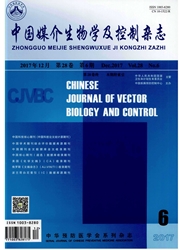

 中文摘要:
中文摘要:
目的调查不同储藏方式的仓储麦麸中螨孳生种类及差异。方法采集皖北地区散储、袋装及桶装3种储藏方式的仓储麦麸样本各25份,分离其中孳生螨,鉴定并计数,对其孳生密度、螨种的丰富度、多样性及均匀度指数等生态学指标进行分析;并采用χ2检验比较3种储藏方式螨孳生率的差异。结果从75份样本中检出8种螨,其中伯氏嗜木螨占40.7%,腐食酪螨占33.3%;散储、袋装和桶装采集样本中,螨的孳生密度分别为0.50、0.25和0.30只/g;螨种丰富度指数分别为1.59、1.18和0.94,多样性指数分别为1.536、1.222和1.167,均匀度指数分别为0.739、0.759和0.725;螨害发生率分别为48.0%、24.0%和16.0%,且三者间差异有统计学意义(χ2=6.047,P〈0.05)。结论皖北地区仓储麦麸中存在螨孳生,其发生率受储藏方式的影响。
 英文摘要:
英文摘要:
Objective To investigate the species and ecological differences of mite breeding in wheat bran stored in different ways.Methods Twenty- five wheat bran samples stored in different ways(bulk, package, and bucket) were collected from northern Anhui province, China. Mites breeding in the samples were isolated, identified, and counted. The following ecological indices were analyzed: breeding density, richness index, diversity index, and evenness index.Differences in the rate of mite breeding between the three storage methods were examined using 2 test.Results Eight species of mites were identified from 75 wheat bran samples, mainly including Caloglyphus berlesei(40.7%) and Tyrophagus putrescentiae(33.3%). The breeding densities of mites in bulk, package, and bucket storage were 0.50, 0.25,and 0.30 mite/g, respectively. The corresponding values of richness index were 1.59, 1.18, and 0.94, respectively; the values of diversity index were 1.536, 1.222, and 1.167, respectively; the values of evenness index were 0.739, 0.759, and 0.725, respectively. The rates of mite breeding in bulk, package, and bucket storage were 48.0%, 24.0%, and 16.0%,respectively, with significant differences between the three storage methods( χ2=6.047, P〈0.05).Conclusion Mite breeding exists in wheat bran storage in northern Anhui province, where the rate of mite breeding is affected by the way of storage.
 同期刊论文项目
同期刊论文项目
 同项目期刊论文
同项目期刊论文
 期刊信息
期刊信息
